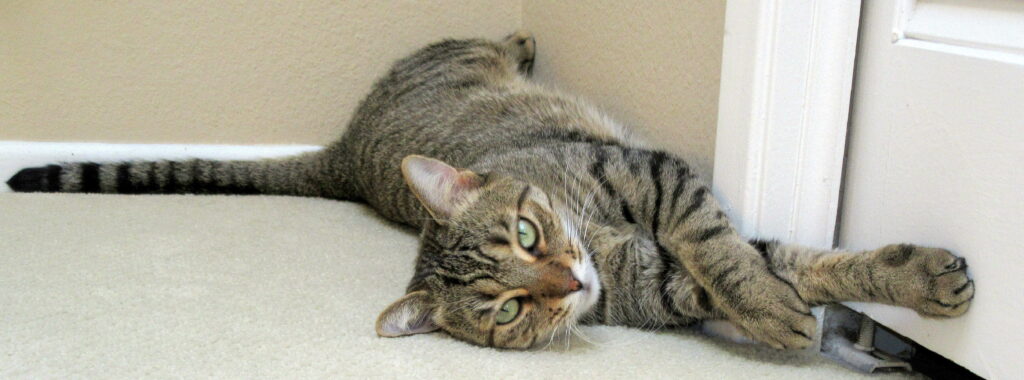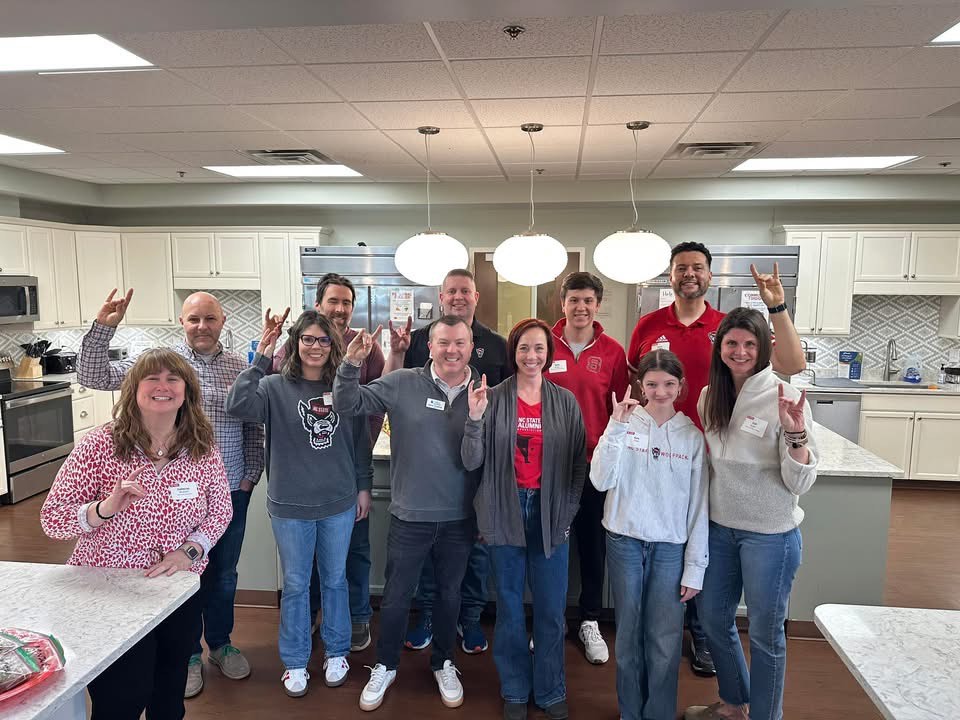Tenacious and Exceptional, NC State Alum’s Care Dazzles Cat’s Companion
To cat owner Stephanie McEwan, NC State College of Veterinary Medicine alumni Tracey Rossi is an exceptional veterinarian determined to go above and beyond the obvious to provide extraordinary medical care to her patients.

To cat owner Stephanie McEwan, NC State College of Veterinary Medicine alumni Tracey Rossi is an exceptional veterinarian determined to go above and beyond the obvious to provide extraordinary medical care to her patients.
Rossi, on the other hand, says that she’s just tenacious and that McEwan, a board-certified medical scientist, is giving her way too much credit for saving the life of Elsa the cat.
Whether McEwan is being too effusive or Rossi too humble matters little to Elsa, a brown tabby cat who survived a prolonged bout with a potentially fatal Cryptococcus fungal infection after Rossi found discrepancies in some lab results and chose to have a different lab test the cat for Cryptococcus markers.
“If Dr. Rossi had relied on back-to-back negative test results and opted to discontinue treatment, my cat’s health would have deteriorated, with serious and disfiguring complications, eventually leading to death,” says McEwan, an adjunct clinical and research faculty member in the Department of Medicine & Surgery at the University of California School of Medicine in Irvine. “Instead, something did not seem right to Dr. Rossi, who chose to think about her patient and to not simply practice ‘autopilot’ medicine.”
In September 2019, Elsa was having severe respiratory distress and odd nasal symptoms and was immediately admitted to the emergency department at Blue Pearl Pet Hospital in Irvine.
Although Elsa was an indoor-only cat, she was found to be positive for Cryptococcus after biopsies of the nasal tissue were taken, and she was started on antifungal medication.
Over the next seven months, Elsa subsequently tested negative several times for the deadly infection, and McEwan was advised to discontinue the medication. However, out of abundance of caution, McEwan was reluctant.
When Elsa’s veterinarian moved to another state, Rossi, an internal medicine specialist at Blue Pearl, took over her care. Rossi had never seen Elsa before, McEwan says, but she carefully reviewed the cat’s file and decided the cat should be tested again, but at a different lab.
“There’s nothing special about what I did,” says Rossi, who graduated from NC State with her DVM in 2003. “I’m detail-oriented. It’s in the details. Internal medicine is the IT department of veterinary medicine. We hear a story, look at the data, compare it to a physical exam and fix it. By being diagnosticians, that’s what we do.”

Much to everyone’s shock, the new lab tests showed that Elsa was still positive for Cryptococcal antigen. What Rossi and McEwan learned was that all labs are not created equal, and a thankful McEwan decided to research the puzzling situation. How is it possible that at least two labs could be wrong?
“It is well-known cryptococcosis is a life-threatening fungal disease in cats so I knew my cat was being treated for a debilitating, life-threatening disease,” McEwan says. “To distract myself from thinking about the unthinkable – that my cat might very well die from cryptococcosis – I started to research feline cryptococcosis.”
McEwan and her research partner, Jane Sykes of the University of California – Davis, wrote an article reporting their novel findings for the Journal of Feline Medicine and Surgery. Sykes is the coauthor of the textbook “Infectious Diseases of the Dog and Cat.” In the article, McEwan included a special acknowledgement to recognize the dedication and expertise of Rossi, whose path to Irvine, California, was not a straight one.
A change of plans
Rossi grew up on a dairy farm in Maryland. She had decided to become a physical therapist when she arrived at UNC-Chapel Hill to finish her undergraduate biology degree. She had already completed two years of community college, staying close to home after her mother was diagnosed with breast cancer.
While working at a local restaurant in Chapel Hill, Rossi was put in contact with Sam Galphin, a well-known local veterinarian and dairy specialist, and her career goals changed.
“I had been hoping to spend time with him over the summer helping on dairy farms,” says Rossi, who calls Galphin instrumental in inspiring her to become a veterinarian. “We went on a trip to Bolivia because there was a TB problem in the human population, and they weren’t sure if it was a human or a cattle issue. I started trying to get into vet school.”
Accepted at the NC State College of Veterinary Medicine, Rossi started her DVM education thinking she would be a dairy veterinarian, but provided the opportunity to explore all aspects of veterinary medicine, she chose to specialize in small animal medicine. By her fourth year, however, she had decided not to apply for an internship or residency to continue her education.
“I was at the point in my life when I was done with school,” Rossi says. “Going further was not something I was entertaining.”
But during a senior clinical rotation in small animal dermatology, she met Dr. Thierry Olivry, a professor of immunodermatology at NC State.
“Dr. Olivry pointed out that I was always asking questions,” Rossi says. “Dr. Olivry said, ‘You’re going to be bored in general practice. If you want a letter of recommendation when you realize you’re making a mistake, I’ll be happy to write it.’”
There is no doubt in my mind that my cat is alive, and thriving, due to the medical expertise and professional skills of Dr. Rossi. Dr. Rossi is an exceptional veterinarian.” — Dr. Stephanie McEwan
She decided he was right and scrambled, ending up completing a small animal rotating internship in internal medicine at the Veterinary Referral & Emergency Center in Norwalk, Connecticut, and then a small animal internal medicine residency at the Cummings School of Veterinary Medicine at Tufts University.
“Throughout my career, I have wanted my work to matter, one way or another,” Olivry says now. “While my contact with students was mainly limited to interactions in the clinics during their dermatology rotation, if I could think that I made a difference in even a handful of students’ lives, then I feel like saying, ‘Mission accomplished.’”
‘It’s OK to leave’
Following her residency, Rossi took a job at a new private practice in Maryland but was unhappy there. The lack of support from management was overwhelming, she says, and she started questioning all of the work she had done the previous 12 years.
“I tell all of my students and interns now, if your first job is a bad fit, it’s OK to leave,” says Rossi, whose position includes teaching Western University College of Veterinary Medicine students during their fourth-year clinical rotation at Blue Pearl Irvine. “And it’s also a lesson for us, too. You work so hard to get somewhere and then you realize this is not what I thought it would be. And you can change.”
She ended up in California and ultimately as Elsa’s life-saving veterinarian because a relief surgeon she met in Maryland asked her to join him at his new practice in Irvine.
“There is no doubt in my mind that my cat is alive, and thriving, due to the medical expertise and professional skills of Dr. Rossi,” says McEwan, who reports that Elsa’s test results are now consistently negative for Cryptococcus. “Dr. Rossi is an exceptional veterinarian.”
All because an NC State faculty member offered an encouraging word to a struggling but promising student and because that student learned that it’s OK to change your mind about your passion, it’s OK for new veterinarians to leave ill-fitting jobs and it’s certainly OK to ask hard questions.
“I’m just tenacious,” Rossi says. “‘You are always asking why,’ Dr. Olivry said. ‘You are always asking why.’ I think that’s just my personality.”
This post was originally published in Veterinary Medicine News.


